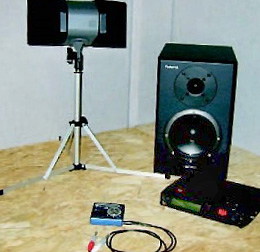
The difference between the two files is the IR, which represents what the room/system did to the sound as it passed from source to receiver.
One way that the IR can be obtained is by a complex mathematical process called deconvolution.
A number of software applications exist that can deconvolve two files. I used SoundForge in this example.
There are other mathematical processes that can be used to get the same result, but the principle is the same.
The system excitation stimulus need not be an impulse. In fact, impulses are a poor choice.
A swept sine wave offers some significant advantages:
• Significantly more energy is fed to the room. This offers dramatic signal-to-noise benefits.
• It’s less likely that you will overload your recorder, since the level of a sine wave doesn’t fluctuate like a noise or impulsive stimulus.
• The simple nature of the waveform allows the recording to be done with most any digital platform. Complex waveforms can be significantly altered by the compression schemes used by some formats.
• It is relatively easy to set recording levels.
Beware that since sine waves generate significant power (that’s why you get a better signal-to-noise ratio), that you do not burn up the loudspeakers used for the test.
The Equipment
There are lots of possibilities here. My setup consists of things that I already had. I created a wave file that contains a 24 second sweep, a 48 second sweep, and an anechoic speech track. The total duration is about two minutes.
I use a MiniDisc player to play the file into the system. It’s a cheapie unit that runs on batteries. As a separate unit, it eliminates the need to string long cables in the venue to excite the system.
Fhe file is recorded on another MiniDisc player/recorder. This one is a little nicer, with XLR inputs and phantom power. It also has SPDIF outputs, which allow the recorded files to be transferred to the PC without converting to analog.
Some of the newer recorders use compact flash or CD media. This is even better, since you can then simply pop the disc into the PC for post-processing. My mic is a Crown SASS, ideal for this application since it emulates a human listener. All of this fits neatly in the SASS case.
The data is gathered by playing the wave file into the system and simply recording it. The 24 second track is used to set the levels, and the 48 second track is the actual file used for post-processing.
